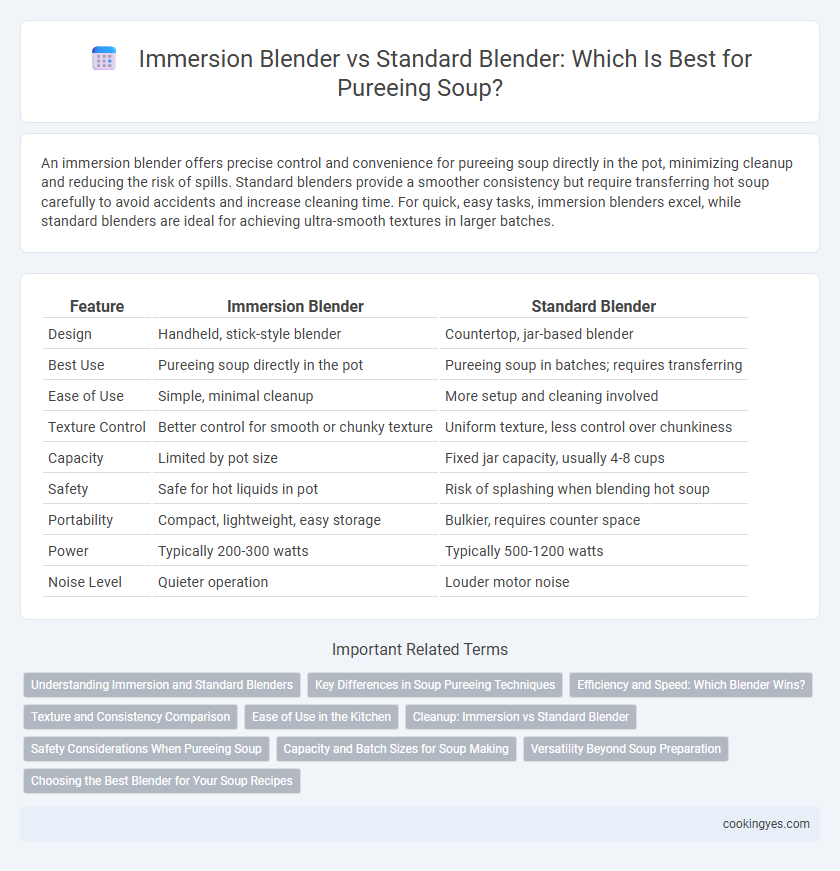An immersion blender offers precise control and convenience for pureeing soup directly in the pot, minimizing cleanup and reducing the risk of spills. Standard blenders provide a smoother consistency but require transferring hot soup carefully to avoid accidents and increase cleaning time. For quick, easy tasks, immersion blenders excel, while standard blenders are ideal for achieving ultra-smooth textures in larger batches.
Table of Comparison
| Feature | Immersion Blender | Standard Blender |
|---|---|---|
| Design | Handheld, stick-style blender | Countertop, jar-based blender |
| Best Use | Pureeing soup directly in the pot | Pureeing soup in batches; requires transferring |
| Ease of Use | Simple, minimal cleanup | More setup and cleaning involved |
| Texture Control | Better control for smooth or chunky texture | Uniform texture, less control over chunkiness |
| Capacity | Limited by pot size | Fixed jar capacity, usually 4-8 cups |
| Safety | Safe for hot liquids in pot | Risk of splashing when blending hot soup |
| Portability | Compact, lightweight, easy storage | Bulkier, requires counter space |
| Power | Typically 200-300 watts | Typically 500-1200 watts |
| Noise Level | Quieter operation | Louder motor noise |
Understanding Immersion and Standard Blenders
Immersion blenders feature a handheld design with a rotating blade shaft that allows direct blending within the pot, making them ideal for pureeing soups without transferring liquids. Standard blenders come with a fixed jar and powerful motor, enabling smoother and more uniform purees but require soup to be cooled and poured in batches to prevent spills. Both appliances excel in different aspects of soup pureeing, with immersion blenders offering convenience and control, while standard blenders provide consistent texture and enhanced blending power.
Key Differences in Soup Pureeing Techniques
Immersion blenders offer precise control and convenience for pureeing soup directly in the pot, minimizing cleanup and preserving heat. Standard blenders create smoother textures but require transferring hot soup, risking spills and heat loss. The choice depends on desired texture, ease of use, and kitchen workflow preferences.
Efficiency and Speed: Which Blender Wins?
Immersion blenders excel in efficiency and speed for pureeing soup directly in the pot, eliminating the need to transfer hot liquids and reducing cleanup time. Standard blenders often require multiple batches due to smaller jar sizes, increasing preparation time and potential spills. For seamless, rapid soup pureeing, immersion blenders provide the fastest, most efficient solution.
Texture and Consistency Comparison
Immersion blenders create smoother, creamier textures by pureeing soup directly in the pot, allowing precise control over the consistency and preventing over-blending. Standard blenders achieve a uniform and velvety texture but require transferring hot soup in batches, which can result in uneven blending and increased prep time. For maintaining optimal texture and consistent thickness, immersion blenders offer greater convenience and customization in soup pureeing.
Ease of Use in the Kitchen
Immersion blenders offer superior ease of use for pureeing soup directly in the pot, eliminating the need to transfer hot liquids and minimizing cleanup. Standard blenders require pouring hot soup into the blender jar, increasing the risk of spills and burns, and often involve multiple steps such as securing the lid and transferring the pureed soup back to the pot. The compact design and one-handed operation of immersion blenders make them a convenient choice for quick, efficient soup preparation.
Cleanup: Immersion vs Standard Blender
Immersion blenders offer a significant advantage in cleanup, as they can be easily rinsed or washed directly in the pot, reducing the number of dishes. Standard blenders require disassembling the jar, lid, and blade components, which can be time-consuming and cumbersome. The simplicity of an immersion blender's design makes cleanup quicker and more convenient for pureeing soups.
Safety Considerations When Pureeing Soup
Immersion blenders offer enhanced safety when pureeing hot soup by allowing users to blend directly in the pot, minimizing the risk of spills and burns associated with transferring hot liquids to a standard blender. Standard blenders require careful handling as hot soup can create pressure buildup, leading to potential lid explosions or scalding accidents if not vented properly. Choosing an immersion blender reduces exposure to hot steam and splashes, making it a safer option for pureeing soups.
Capacity and Batch Sizes for Soup Making
Immersion blenders offer versatility for pureeing soups directly in the cooking pot, making them ideal for small to medium batch sizes up to 4 liters without transferring hot liquids. Standard blenders typically have larger jar capacities, often ranging from 1.5 to 2 liters per batch, requiring multiple blends for larger quantities and extra handling. Choosing between the two depends on whether frequent large-batch preparation is needed or convenience and ease of cleaning are priorities for smaller soup volumes.
Versatility Beyond Soup Preparation
Immersion blenders offer superior versatility beyond soup preparation, seamlessly blending smoothies, sauces, and salad dressings directly in the container, reducing cleanup time. Standard blenders deliver powerful, consistent results ideal for crushing ice and making large batches of pureed soups or frozen desserts. Both tools expand kitchen capabilities, but immersion blenders provide greater convenience and adaptability for quick, small-batch tasks.
Choosing the Best Blender for Your Soup Recipes
An immersion blender offers superior control and convenience for pureeing soups directly in the pot, reducing cleanup and preserving heat. Standard blenders provide powerful, consistent blending ideal for large batches or thicker soups but require transferring hot liquids, which can be cumbersome and risky. Selecting the best blender depends on your soup recipe's texture preferences, batch size, and ease of use during preparation.
Immersion blender vs Standard blender for pureeing soup Infographic

 cookingyes.com
cookingyes.com